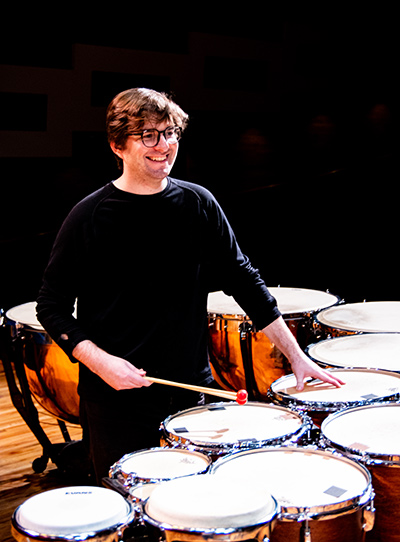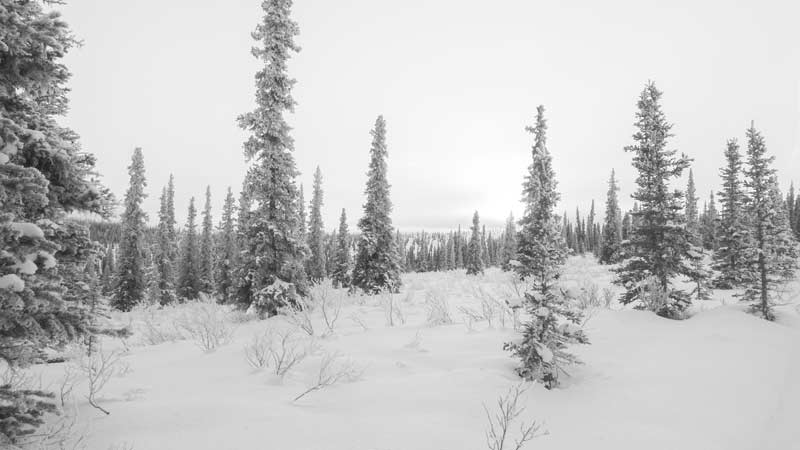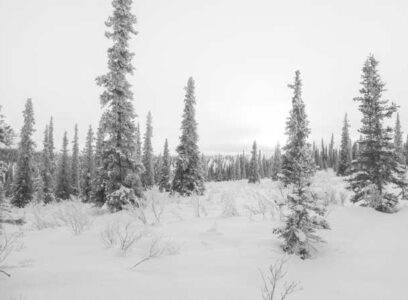Sean Dowgray
Boreal Soundscape
Boreal Soundscape presents a sonic ecosystem made of field recordings throughout Alaska, found sounds throughout my exploration, and performed sounds of my own creation. Using these three modes, I have created a collection of pieces that sound throughout a space via small speakers.
Each piece has a particular theme which drives its sonic materials. These themes draw on my own observations and experiences throughout ITOC, as well as presentations and information from other ITOC artists and scientists. The field recordings took place throughout my participation in ITOC; they are what I consider to be a sonic journaling throughout my exploration of the boreal forest. The found sounds consist of those which I came upon unexpectedly in some manner or another — for example, the large sheets of ice that formed in the layerings of snow from the snow/rain storms of December 2021, an unusual display of weather for the month of December. The performed sounds consist of a variety of percussion instruments which I have carefully paired with the field recordings and found sounds through considerations of duration, texture, timbre, and tone.
Through these three modes of approach, I reimagine a relationship between music and nature, where objects and aspects of the boreal are heard directly, taking on musically expressive roles, while the performed sounds offer a musical dialogue, as if originally hidden in aspects and features of the boreal forest, extracted throughout the ITOC process, and heard as a culminating result in this soundscape.
Day & Night | Tone & Texture
These sounds take you through a progression of day and night in Fairbanks over one year. There are twelve separate “days,” each representing the first day of each month and each lasting for 24 minutes. Each day is filled with tones and textures that are indicative of their respective period of year. Tones represent the daylight while textures represent the night. The duration of the tones correspond to the amount of light that that specific day in the year receives, therefore summer months contain more tones while winter months contain more textures.
Sounds heard: vibraphone, glockenspiel, ebow on piano, snow at night, snow on leaves, snow on concrete, ice skater on frozen pond, ice, melting ice cave, melting snow on metal pipe, dripping icicles VLF recordings of the aurora borealis, rain on leaves, rain on concrete, wind in denali, wind through spruce trees, almglocken, crotales, chena river, goldstream creek, large vehicles for snow removal, burning embers, crackling charcoal
Length: 4 hours, 48 minutes
Contributors: Stephen McGreevey, VLF recordings of the aurora borealis
Walking Project
As a musician, I have moved and lived in various parts of the world for various periods of time whether for study or performance. What I remember most about each place are the walks that I have taken there, whether they were tourist walks, walks towards an engagement of some kind, or daily walks from apartment to music building for practice and rehearsals. This inspired me to record my walks throughout a year in Fairbanks and compile them as a means of hearing the change of season through foot and ground. Dry ground becomes wet, it freezes, snow overlays, snow layers and deepens, it gradually melts, and dry ground returns.
Sounds heard: feet on fresh snow, feet on on snowpack, feet in deep snow, feet on melting snow, feet on foliage, feet on earth, feet on ice, ice crackling, rain on foliage, woodblocks, vibraphone, glockenspiel, wind, crow, motor vehicles
Length: 24 minutes
Contributors: Sean Van Winkle, field artist
Nitrogen Cycles
This work is inspired by Tamara Harms’ ITOC presentation, “The Nitrogen Cycle.” Harms discusses the importance of organic nitrogen to living things, that gaseous nitrogen contributes to climate warming, and the ways in which analyzing nitrogen cycles can give us clues about environmental changes. However, the nitrogen cycle is invisible to us, and Harms notes a struggle in valuing “invisible” things. It is no surprise then that representing an invisible cycle would be a difficult thing to do musically which led me to draw on one of the few recordings beyond the boreal forest. I chose to use a recording of a tube atop a mountain activated by wind at the now-closed Chacaltaya ski resort in Bolivia. The ski resort is no longer in operation due to climate change. Now a ghost of its past, and the tube whistles a foreboding message to the rest of us from wind which no longer brings snow fall. I relate the tones from the wind hitting the tube to the possible messages embedded in Harms’ analyses of the nitrogen cycle. Diurnal fluctuations in nitrogen are represented by the sounding of two streams (recorded both day and night) which fade in and out periodically. A “storm” is occasionally heard which increases nitrogen in streams draining melting permafrost. Various percussion instruments sound, representing the ways in which plants and bacteria make inert nitrogen available to animals.
Sounds heard: aluminum pipes, vibraphone, wind in trees, ballaine lake, chena river, wind on chacaltaya tube (metal), ace lake, wind in leaves, bowed cymbal, bowed sizzle cymbal, small whistles, harmonicas
Length: 1 hour
Contributors: Felix Blume, field artist
Objects of the Boreal Forest
To a percussionist, anything goes. Whether an object was created with musical purpose in mind or for something else entirely, percussionists recognize musical potentiality in objects of all types. Throughout ITOC, I have sought to find expressive potential in the objects and materials of the boreal forest. In this work, objects including ice, snow, water, foliage, earth, and stone blend with an array percussion instruments in order to create a boreal soundworld.
Sounds heard: snow, ice, water, trees, twigs, leaves, pines, logs, bark, wood blocks, temple blocks, singing bowls, cymbals, various skins, various metals, various woods, vibraphone, glockenspiel, marimba, xylophone, stones, bells, whistles, flexatone, ratchet, gongs
Thunderstorm
One of my favorite weather events from growing up in the midwest is the thunderstorm. In a recent article by the Yale Climate Connections, they state that the number of thunderstorms in the rapidly warming state of Alaska could triple by 2100.
sea ice is melting – giving way to open water, which evaporates more easily. With that, we expect more moisture to be present in the atmosphere… which gives the conditions for thunderstorm days. -YCC team, Sarah Kennedy/ChavoBart Digital Media
In one sense, I welcome the rain, lightning, and thunder in Alaska as it is an experience I have missed while living in drier climates throughout most of my professional life. However, increased thunderstorms bring a message of more radical events such as flash flooding, landslides, and increased wildfires. This work collages a collection of field recordings taken in Fairbanks but also throughout the lower 48. It is here that I imagine what the future of Fairbanks weather might sound like.
Sounds heard: thunderstorms in kansas, thunderstorms in tennessee, rain in fairbanks, wind in denali, burning wood, burning charcoal, headphones on piano, piano strings, ebow on piano, metals, woods, skins, whistles, cymbals, thunder sheets, tamtams, keys, sirens, wires vibrating in wind
Length: 1 hour, 36 minutes
Sean Dowgray
Sean Dowgray (D.M.A) is a classical percussionist specializing in modern and contemporary music. As a solo artist, Dowgray explores creative methodologies that are heedful of the physical world and its phenomena. Through percussion, he considers the ways in which music gives rise to time and cultivates a creative practice that engages with the known properties and standing mysteries of mass and matter, force and motion, energy and charge. Dowgray has been a featured soloist at the Percussive Arts Society International Convention (PASIC), Harvard’s Radcliffe Institute for Advanced Learning, the Oberlin Percussion Institute, the WasteLAnd New Music Series, and others.
Website: seandowgray.com


